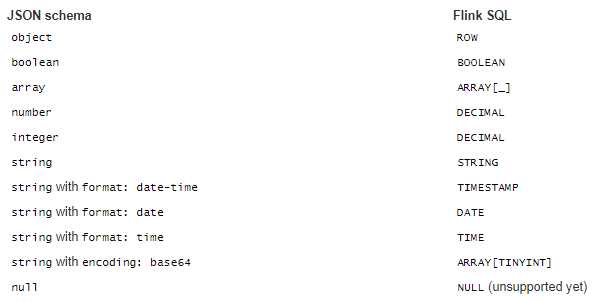标签:als category into 官网 rap time content schema exce
在 Flink 1.10 的 Table API 和 SQL 中,表支持的格式有四种:
CSV Format
JSON Format
Apache Avro Format
Old CSV Format
官网地址如下:https://ci.apache.org/projects/flink/flink-docs-release-1.10/dev/table/connect.html#table-formats
我用 JSON Format 比较多,也有嵌套的JSON 数据需要解析,大概描述一下。
以下内容来下官网介绍:
JSON格式允许读取和写入与给定格式 schema 相对应的JSON数据。 格式 schema 可以定义为Flink类型,JSON schema 或从所需的表 schema 派生。 Flink类型启用了更类似于SQL的定义并映射到相应的SQL数据类型。 JSON模式允许更复杂和嵌套的结构。
如果格式 schema 等于表 schema,则也可以自动派生该 schema。 这只允许定义一次 schema 信息。 格式的名称,类型和字段的顺序由表的 schema 确定。 如果时间属性的来源不是字段,则将忽略它们。 表 schema 中的from定义被解释为以该格式重命名的字段。
大概意思就是,flink 在解析json的时候,可以自己通过 schema(支持复杂的嵌套json),如果不提供 schema,默认使用 table schema 自动派生 json 的 schema(不支持复杂json)。
官网对应 json format 的表的样例:
CREATE TABLE MyUserTable ( ... ) WITH ( ‘format.type‘ = ‘json‘, -- required: specify the format type ‘format.fail-on-missing-field‘ = ‘true‘ -- optional: flag whether to fail if a field is missing or not, false by default ‘format.fields.0.name‘ = ‘lon‘, -- optional: define the schema explicitly using type information. ‘format.fields.0.data-type‘ = ‘FLOAT‘, -- This overrides default behavior that uses table‘s schema as format schema. ‘format.fields.1.name‘ = ‘rideTime‘, ‘format.fields.1.data-type‘ = ‘TIMESTAMP(3)‘, ‘format.json-schema‘ = -- or by using a JSON schema which parses to DECIMAL and TIMESTAMP. ‘{ -- This also overrides the default behavior. "type": "object", "properties": { "lon": { "type": "number" }, "rideTime": { "type": "string", "format": "date-time" } } }‘ )
注:flink 1.10 字段的名称和类型可以从 table schema 中推断,不用写 format.fields.0.name 和 format.fields.0.data-type 了。
CREATE TABLE user_log( user_id VARCHAR, item_id VARCHAR, category_id VARCHAR, behavior VARCHAR, ts TIMESTAMP(3) ) WITH ( ‘connector.type‘ = ‘kafka‘, ‘connector.version‘ = ‘universal‘, ‘connector.topic‘ = ‘user_behavior‘, ‘connector.properties.zookeeper.connect‘ = ‘venn:2181‘, ‘connector.properties.bootstrap.servers‘ = ‘venn:9092‘, ‘connector.startup-mode‘ = ‘earliest-offset‘, ‘format.type‘ = ‘json‘ );
对应 json 数据如下:
{"user_id": "315321", "item_id":"942195", "category_id": "4339722", "behavior": "pv", "ts": "2017-11-26T01:00:00Z"}
对应的字段,会映射到对应的类型上,可以直接使用,比1.9 方便了不少。
当然,这个并不是这里的主要内容。
先来个嵌套的json看下:
{"user_info":{"user_id":"0111","name":"xxx"},"timestam":1586670908699,"id":"10001"}
这样的复杂sql该怎么解析呢?
回来看下官网那段实例:
‘format.json-schema‘ = -- or by using a JSON schema which parses to DECIMAL and TIMESTAMP. ‘{ -- This also overrides the default behavior. "type": "object", "properties": { "lon": { "type": "number" }, "rideTime": { "type": "string", "format": "date-time" } } }‘
SQL 的properties 中可以通过 属性 "format.json-schema" 设置输入的 json schema。
Flink 的 json-schema 中支持如下的数据类型:

再来看下刚刚的嵌套json:
{"user_info":{"user_id":"0111","name":"xxx"},"timestam":1586670908699,"id":"10001"}
第一层的 timestam、id 直接就映射到字段上,而 user_info 也是个json。
从上面的实例上,可以看到 object 类型数据有 properties,而properties 的内容,怎么看都想是json的内层数据。
所以上面的sql 对应的 json-schema 是这样的:
‘format.json-schema‘ = ‘{
"type": "object",
"properties": {
"id": {type: "string"},
"timestam": {type: "string"},
"user_info":{type: "object",
"properties" : {
"user_id" : {type:"string"},
"name":{type:"string"}
}
}
}
}‘
从上面的 json schame 和 Flink SQL 的映射关系可以看出,user_info 对应的table 字段的类型是ROW,所以 table 的schema 是这样的:
CREATE TABLE user_log(
id VARCHAR,
timestam VARCHAR,
user_info ROW(user_id string, name string )
)
ROW 类型的 user_info,有两个字段:user_id 和 name
注:使用的时候,直接用 "." 就可以了:如 user_info.user_id
到此,嵌套json的 schame 就搞定了。
下面我们再来看下 嵌套 json 数组:
{"user_info":{"user_id":"0111","name":"xxx"},"timestam":1586670908699,"id":"10001","jsonArray":[{"name222":"xxx","user_id222":"0111"}]}
这个又该怎么写 json schema 呢?
官网有个实例说 json format 直接解析这样的复杂 json:
"optional_address": { "oneOf": [ { "type": "null" }, { "$ref": "#/definitions/address" } ] }
太长了,截取一段,官网明确说了支持这样的实例,也就是支持 json 数组
json schema 和 Flink SQL 的映射关系中, json 的 array 对应 Flink SQL的 ARRAY[_]
按照 object 类型的写法,写了个这样的:
"jsonArray":{"type": "array",
"properties": {
"type": "object",
"properties" : {
"user_id222" : {type:"string"},
"name222" : {type:"string"}
}
}
}
收获了一个 exception:
Caused by: java.lang.IllegalArgumentException: Arrays must specify an ‘items‘ property in node: <root>/jsonArray at org.apache.flink.formats.json.JsonRowSchemaConverter.convertArray(JsonRowSchemaConverter.java:264) at org.apache.flink.formats.json.JsonRowSchemaConverter.convertType(JsonRowSchemaConverter.java:176) at org.apache.flink.formats.json.JsonRowSchemaConverter.convertObject(JsonRowSchemaConverter.java:246)
然后,当然是 debug 代码了: org.apache.flink.formats.json.JsonRowSchemaConverter 就是解析 json-schema 的代码了
JsonRowSchemaConverter 类有3个主要的方法分别对应解析不同类型的数据:
// 解析 type private static TypeInformation<?> convertType(String location, JsonNode node, JsonNode root) // 解析 object private static TypeInformation<Row> convertObject(String location, JsonNode node, JsonNode root) // 解析 array private static TypeInformation<?> convertArray(String location, JsonNode node, JsonNode root)
convertType 方法在这里解析具体字段和类型:
for (String type : types) { // set field type switch (type) { case TYPE_NULL: typeSet.add(Types.VOID); break; case TYPE_BOOLEAN: typeSet.add(Types.BOOLEAN); break; case TYPE_STRING: if (node.has(FORMAT)) { typeSet.add(convertStringFormat(location, node.get(FORMAT))); } else if (node.has(CONTENT_ENCODING)) { typeSet.add(convertStringEncoding(location, node.get(CONTENT_ENCODING))); } else { typeSet.add(Types.STRING); } break; case TYPE_NUMBER: typeSet.add(Types.BIG_DEC); break; case TYPE_INTEGER: // use BigDecimal for easier interoperability // without affecting the correctness of the result typeSet.add(Types.BIG_DEC); break; case TYPE_OBJECT: typeSet.add(convertObject(location, node, root)); break; case TYPE_ARRAY: typeSet.add(convertArray(location, node, root)); break; default: throw new IllegalArgumentException( "Unsupported type ‘" + node.get(TYPE).asText() + "‘ in node: " + location); } }
简单类型,就直接添加对应的 Flink SQL 类型, 复杂类型的 object、array 由单独的方法解析,这里我们看下 covertArray:
private static TypeInformation<?> convertArray(String location, JsonNode node, JsonNode root) { // validate items if (!node.has(ITEMS)) { throw new IllegalArgumentException( "Arrays must specify an ‘" + ITEMS + "‘ property in node: " + location); } final JsonNode items = node.get(ITEMS); // list (translated to object array) if (items.isObject()) { final TypeInformation<?> elementType = convertType( location + ‘/‘ + ITEMS, items, root); // result type might either be ObjectArrayTypeInfo or BasicArrayTypeInfo for Strings return Types.OBJECT_ARRAY(elementType); } // tuple (translated to row) else if (items.isArray()) { final TypeInformation<?>[] types = convertTypes(location + ‘/‘ + ITEMS, items, root); // validate that array does not contain additional items if (node.has(ADDITIONAL_ITEMS) && node.get(ADDITIONAL_ITEMS).isBoolean() && node.get(ADDITIONAL_ITEMS).asBoolean()) { throw new IllegalArgumentException( "An array tuple must not allow additional items in node: " + location); } return Types.ROW(types); } throw new IllegalArgumentException( "Invalid type for ‘" + ITEMS + "‘ property in node: " + location); }
注:更多信息请查看源码(org.apache.flink.formats.json.JsonRowSchemaConverter)
从上面的代码可以看出,从 convertTypes 中解析到是 array 类型的,就调用 convertArray 方法,而 convertArray 方法中第一步就是判断是否有个 ITEMS 字段,没有直接就报错:
Arrays must specify an ‘items‘ property in node: <root>/jsonArray
有就 final JsonNode items = node.get(ITEMS) get 出来继续解析,判断 items 是个 object 或 array (然后继续递归),都不是就抛出异常
从源码可以看出 json 数组类型的 json schema 就是这样的:
CREATE TABLE user_log( id VARCHAR, timestam VARCHAR, user_info ROW(user_id string, name string ), jsonArray ARRAY<ROW(user_id222 STRING, name222 STRING)> ) WITH ( ‘connector.type‘ = ‘kafka‘, ‘connector.version‘ = ‘universal‘, ‘connector.topic‘ = ‘complex_string‘, ‘connector.properties.zookeeper.connect‘ = ‘venn:2181‘, ‘connector.properties.bootstrap.servers‘ = ‘venn:9092‘, ‘connector.startup-mode‘ = ‘earliest-offset‘, ‘format.type‘ = ‘json‘, ‘format.json-schema‘ = ‘{ "type": "object", "properties": { "id": {type: "string"}, "timestam": {type: "string"}, "user_info":{type: "object", "properties" : { "user_id" : {type:"string"}, "name":{type:"string"} } }, "jsonArray":{"type": "array", "items": { "type": "object", "properties" : { "user_id222" : {type:"string"}, "name222" : {type:"string"} } } } } }‘ );
看过源码之后,对于上面的json schema 就没有难度了
这里还要说下 json array 中有多个元素的案例:
{"user_info":{"user_id":"0111","name":"xxx"},"timestam":1586676835655,"id":"10001","jsonArray":[{"name222":"xxx","user_id222":"0022"},{"name333":"name3333","user_id222":"user3333"},{"cc":"xxx333","user_id444":"user4444","name444":"name4444"}]}
对应的 schema 也是这样的:
"jsonArray":{"type": "array",
"items": {
"type": "object",
"properties" : {
"user_id222" : {type:"string"},
"name222" : {type:"string"}
}
}
}
}
因为在解析 json array 的时候,只能获取到一个 items 字段(多加也没用),会拿这个schema 去解析 json array 里面的所有元素,有对应字段就赋值,没用就为空
表的列也是这样的:
jsonArray ARRAY<ROW(user_id222 STRING, name222 STRING)>
在查询中直接使用 jsonArray 会将所有数据直接查出来:
INSERT INTO user_log_sink SELECT * FROM user_log;
输出的数据如下:
{"id":"10001","timestam":"1586676835655","user_info":{"user_id":"0111","name":"xxx"},"jsonArray":[{"user_id222":"0022","name222":"xxx"},{"user_id222":"user3333","name222":null},{"user_id222":null,"name222":null}]}
json array 中的第一个元素 全部解出来了,第二个元素只有 user_id222 有值,第三个元素都没解析出来
注:json array 是这样使用的:jsonArray[1].user_id222 # 代表 jsonArray 中的第一个元素的 user_id222 字段,数组下标从 1 开始,0 或 大于实际 json array 中的 长度会报 : java.lang.ArrayIndexOutOfBoundsException: 1
欢迎关注Flink菜鸟公众号,会不定期更新Flink(开发技术)相关的推文

标签:als category into 官网 rap time content schema exce
原文地址:https://www.cnblogs.com/Springmoon-venn/p/12664547.html